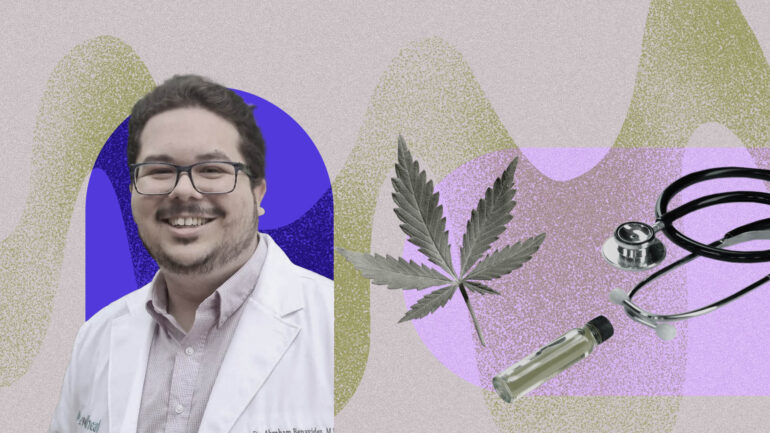The benefits of the cannabis plant don’t just come down to the cannabinoids it contains. As the Farm Bill legalized the whole spectrum of cannabinoids when found in hemp, more and more people became aware of the huge variety of beneficial molecules found in the plant.
But as more cannabinoids become household names, there is still a whole class of compounds from the plant that we know very little about and the general user might miss the importance of terpenes.
Dr. Abraham Benavides is an international cannabis consultant, a cannabis coach with the GW Center for Integrative Medicine and a bona fide expert on terpenes. In 2016, he started the Cannabis as Medicine Interest Group at George Washington University’s School of Medicine and Health Sciences, the first such group at a U.S. university, and has authored continuing medical education courses and cannabis ebooks at various publications.
We caught up with Dr. Abe to talk terpenes, especially how they contribute to the entourage effect and the current state of terpene science.
Terpenes and Their Role in the Entourage Effect Explained
The “entourage effect” is an important concept in the cannabis space. The basic idea is that the different components in cannabis are better together than they are when isolated and taken individually – for example, CBD plus THC, CBG, and other cannabinoids are more beneficial than just CBD alone.
Dr. Abe points out that this is an old concept, much older than people might think.
He told us that it was formulated by the same team that discovered the endocannabinoid system (i.e. the body’s internal cannabinoid system), including legendary researcher Dr. Raphael Mechoulam.
Dr. Abe explained that “They were originally measuring cannabinoid and endocannabinoid synergy. Later on, other researchers like Jeremy Johnson and EB Russo found that major and minor cannabinoids synergize, too, along with terpenes.”
Dr. Abe adds, “Since the well-known 2011 EB Russo paper, evidence is gradually accumulating showing the synergistic and cannabinoid-enhancing roles that terpenes and other whole-plant compounds play in the entourage effect. This sparked a new interest in whole-plant cannabis medicine that’s carried on over the last 15 years.”
While most of the focus around the entourage effect has been on cannabinoid synergies, Dr. Abe points out, “I think it’s safe to say that terpenes and other whole-plant components like flavonoids play a significant role in the entourage effect. Even at low levels, they can enhance certain therapeutic and recreational effects. They also contribute to the appealing fruity and earthy smells of many cultivars, as commonly seen with over 20,000 known terpenes elsewhere.”
The study Dr. Abe cited showed that terpenes activate the CB1 cannabinoid receptors, at between 10% and 50% of the level of THC, even when tested in isolation. When you combine them with THC, the authors report that activity at the receptor is significantly increased compared to THC alone, in fact sometimes by several hundred percent. This is right in line with what advocates of the entourage effect claim.
How Much Evidence Do We Have for the Benefits of Terpenes?
While results like those cited by Dr. Abe in the last section are enough for many cannabis advocates to go all in on the entourage effect and terpenes, many in the scientific community are not so convinced.
Dr. Abe is all too aware of this, “Critics of the entourage effect cite the lack of compelling clinical data. While there aren’t large-scale, rigorous trials, in my opinion it’s way too early to dismiss the therapeutic potential of terpenes.”
He explained that, “The evidence base for terpenes is largely in the preclinical stage. Many early studies show the addition of terpenes or use of whole-plant extracts can yield greater therapeutic benefits and specific pain-relieving, antianxiety, anticancer, chemo synergistic, organ-protective, antiepileptic, antimicrobial actions, and more – with lower doses than isolates.”
Acknowledging, “Since this info is nearly all based on test-tube and animal studies, we can’t say with certainty for humans yet.”
But there is a difference between acknowledging the problems with the current state of the evidence and simply giving up on the possibility, as Dr. Abe told us: “If you choose to dismiss terpenes and walk away from trying before extensive clinical trials are done, how will society ever move forward? Also, few small clinical trials on terpenes alone and in combination with cannabinoids and whole-plant components already exist. The clinical data on these combinations are small, but positive and supportive and only growing day by day.”
He argued that, “the actual evidence produced to date is enough to support the use of whole-plant over isolates” and pointed out that the risks from natural terpenes are so low that making recommendations doesn’t harm patients.
As a cannabis coach who helps patients, Dr. Abe said he already benefits from the knowledge we have about terpenes:
“Knowing which terpenes have particular neuroprotective, antianxiety, anticancer, or other special effects is already helping providers like me hone in on more precise cannabis therapeutics. Most providers simply don’t have the time to delve into these cutting-edge studies, nor realize there is already a sizable mosaic map of useful research right in front of them. I love helping patients and providers alike get a bird’s eye view of these topics through my work.”
What’s Next for Terpenes?
It goes without saying that we need more evidence on terpenes and their role in the entourage effect, but when we hone in on what exactly helps in what situations, things could really start to improve.
Dr. Abe pointed to a future where terpene profiles are made to measure, “In the future, I can picture more advanced dispensaries where patients can custom-order true, full-spectrum products with any fully customizable ratio and selection of cannabinoids, terpenes, and more. Even better if providers can someday send in product recommendations ahead of pickup.”
Until then, we can at least depend on experts like Dr. Abe to point us in the right direction.
